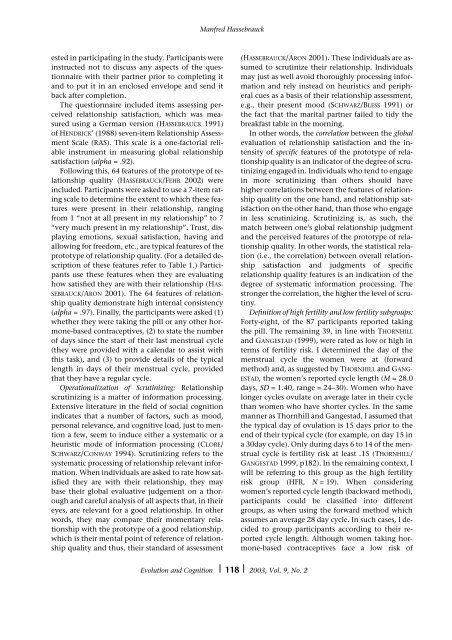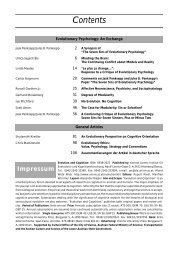Contents - Konrad Lorenz Institute
Contents - Konrad Lorenz Institute
Contents - Konrad Lorenz Institute
You also want an ePaper? Increase the reach of your titles
YUMPU automatically turns print PDFs into web optimized ePapers that Google loves.
Manfred Hassebrauck<br />
ested in participating in the study. Participants were<br />
instructed not to discuss any aspects of the questionnaire<br />
with their partner prior to completing it<br />
and to put it in an enclosed envelope and send it<br />
back after completion.<br />
The questionnaire included items assessing perceived<br />
relationship satisfaction, which was measured<br />
using a German version (HASSEBRAUCK 1991)<br />
of HENDRICK’ (1988) seven-item Relationship Assessment<br />
Scale (RAS). This scale is a one-factorial reliable<br />
instrument in measuring global relationship<br />
satisfaction (alpha = .92).<br />
Following this, 64 features of the prototype of relationship<br />
quality (HASSEBRAUCK/FEHR 2002) were<br />
included. Participants were asked to use a 7-item rating<br />
scale to determine the extent to which these features<br />
were present in their relationship, ranging<br />
from 1 “not at all present in my relationship” to 7<br />
“very much present in my relationship”. Trust, displaying<br />
emotions, sexual satisfaction, having and<br />
allowing for freedom, etc., are typical features of the<br />
prototype of relationship quality. (For a detailed description<br />
of these features refer to Table 1.) Participants<br />
use these features when they are evaluating<br />
how satisfied they are with their relationship (HAS-<br />
SEBRAUCK/ARON 2001). The 64 features of relationship<br />
quality demonstrate high internal consistency<br />
(alpha = .97). Finally, the participants were asked (1)<br />
whether they were taking the pill or any other hormone-based<br />
contraceptives, (2) to state the number<br />
of days since the start of their last menstrual cycle<br />
(they were provided with a calendar to assist with<br />
this task), and (3) to provide details of the typical<br />
length in days of their menstrual cycle, provided<br />
that they have a regular cycle.<br />
Operationalization of Scrutinizing: Relationship<br />
scrutinizing is a matter of information processing.<br />
Extensive literature in the field of social cognition<br />
indicates that a number of factors, such as mood,<br />
personal relevance, and cognitive load, just to mention<br />
a few, seem to induce either a systematic or a<br />
heuristic mode of information processing (CLORE/<br />
SCHWARZ/CONWAY 1994). Scrutinizing refers to the<br />
systematic processing of relationship relevant information.<br />
When individuals are asked to rate how satisfied<br />
they are with their relationship, they may<br />
base their global evaluative judgement on a thorough<br />
and careful analysis of all aspects that, in their<br />
eyes, are relevant for a good relationship. In other<br />
words, they may compare their momentary relationship<br />
with the prototype of a good relationship,<br />
which is their mental point of reference of relationship<br />
quality and thus, their standard of assessment<br />
(HASSEBRAUCK/ARON 2001). These individuals are assumed<br />
to scrutinize their relationship. Individuals<br />
may just as well avoid thoroughly processing information<br />
and rely instead on heuristics and peripheral<br />
cues as a basis of their relationship assessment,<br />
e.g., their present mood (SCHWARZ/BLESS 1991) or<br />
the fact that the marital partner failed to tidy the<br />
breakfast table in the morning.<br />
In other words, the correlation between the global<br />
evaluation of relationship satisfaction and the intensity<br />
of specific features of the prototype of relationship<br />
quality is an indicator of the degree of scrutinizing<br />
engaged in. Individuals who tend to engage<br />
in more scrutinizing than others should have<br />
higher correlations between the features of relationship<br />
quality on the one hand, and relationship satisfaction<br />
on the other hand, than those who engage<br />
in less scrutinizing. Scrutinizing is, as such, the<br />
match between one’s global relationship judgment<br />
and the perceived features of the prototype of relationship<br />
quality. In other words, the statistical relation<br />
(i.e., the correlation) between overall relationship<br />
satisfaction and judgments of specific<br />
relationship quality features is an indication of the<br />
degree of systematic information processing. The<br />
stronger the correlation, the higher the level of scrutiny.<br />
Definition of high fertility and low fertility subgroups:<br />
Forty-eight, of the 87 participants reported taking<br />
the pill. The remaining 39, in line with THORNHILL<br />
and GANGESTAD (1999), were rated as low or high in<br />
terms of fertility risk. I determined the day of the<br />
menstrual cycle the women were at (forward<br />
method) and, as suggested by THORNHILL and GANG-<br />
ESTAD, the women’s reported cycle length (M = 28.0<br />
days, SD = 1.40, range = 24–30). Women who have<br />
longer cycles ovulate on average later in their cycle<br />
than women who have shorter cycles. In the same<br />
manner as Thornhill and Gangestad, I assumed that<br />
the typical day of ovulation is 15 days prior to the<br />
end of their typical cycle (for example, on day 15 in<br />
a 30day cycle). Only during days 6 to 14 of the menstrual<br />
cycle is fertility risk at least .15 (THORNHILL/<br />
GANGESTAD 1999, p182). In the remaining context, I<br />
will be referring to this group as the high fertility<br />
risk group (HFR, N = 19). When considering<br />
women’s reported cycle length (backward method),<br />
participants could be classified into different<br />
groups, as when using the forward method which<br />
assumes an average 28 day cycle. In such cases, I decided<br />
to group participants according to their reported<br />
cycle length. Although women taking hormone-based<br />
contraceptives face a low risk of<br />
Evolution and Cognition ❘ 118 ❘ 2003, Vol. 9, No. 2








